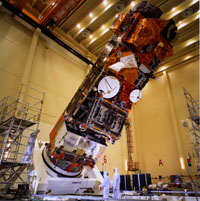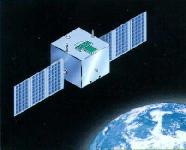

|
|
 The IOCCG is pleased to announce that it will be coordinating and co-sponsoring another advanced training course on ocean-colour in Cape Town, South Africa from 3 -13 December, 2001. The course entitled "Remote Sensing of Ocean Colour: Analysis and Applications" will focus on coastal upwelling off the west coast of Africa, with an emphasis on analyzing SeaWiFS ocean-colour data from the area. The course is open to young scientists and post-graduate students from Africa who are interested in ocean colour and its applications. A limited number of scholarships will be available (submission deadline 15 August, 2001). Please consult the IOCCG Training & Education page for further details on the training course.
Envisat launch fast approaching !  Last month the European Space Agency's new Earth-observing satellite, Envisat, was transported from the European Space Research and Technology Center (ESTEC) in Noordwijk, The Netherlands, to Europe's spaceport in Kourou, French Guiana (South America) on board an Antonov 124 - the only transport aircraft large enough to accommodate the 10-meter tall, 8-tonne satellite! Engineers are now busy preparing the satellite for launch (tentatively scheduled for 2 October, 2001) aboard an Ariane-5 rocket. Envisat is the biggest and most complex Earth observation satellite ever built, with a unique combination of sensors that will vastly improve the range and accuracy of scientific measurements of the atmosphere, oceans, land surface and ice. Among the satellite's ten highly sophisticated instruments is a new Medium Resolution Imaging Spectrometer (MERIS) for monitoring ocean colour and vegetation. Data gathered from the satellite's ten instruments will be transmitted down to ESA's ground stations and will become available to the general scientific and research community after an initial six month commissioning phase.
KDD Services at the GES DAAC  The Goddard Earth Sciences (GES) Distributed Active Archive Center (DAAC) have recently developed a technique known as "knowledge discovery from data bases" (KDD) to extract subsets of data from large satellite data sets in order to reduce the volume of shipped data. This is especially useful for researchers who would like to search the archived data for specific phenomena or where researchers would like to supply their own KDD algorithms. A prototype system was developed and tested with cooperation and funding from the TRMM (Tropical Rainfall Measuring Mission) Program using a variety of algorithms from several investigators. The data volume reduction factors ranged from a factor of 3 to about 40. According to Steve Kempler, Head of the Goddard Earth Sciences Data and Information Services Center, the present KDD system is a prototype and is expected to improve and also to expand to accommodate MODIS data. Inquiries about future KDD efforts for MODIS Level 1 and Ocean and Atmospheric science products should be sent to Bruce Vollmer (vollmer@daac.gsfc.nasa.gov)
The Goddard Earth Sciences (GES) Distributed Active Archive Center (DAAC) have recently developed a technique known as "knowledge discovery from data bases" (KDD) to extract subsets of data from large satellite data sets in order to reduce the volume of shipped data. This is especially useful for researchers who would like to search the archived data for specific phenomena or where researchers would like to supply their own KDD algorithms. A prototype system was developed and tested with cooperation and funding from the TRMM (Tropical Rainfall Measuring Mission) Program using a variety of algorithms from several investigators. The data volume reduction factors ranged from a factor of 3 to about 40. According to Steve Kempler, Head of the Goddard Earth Sciences Data and Information Services Center, the present KDD system is a prototype and is expected to improve and also to expand to accommodate MODIS data. Inquiries about future KDD efforts for MODIS Level 1 and Ocean and Atmospheric science products should be sent to Bruce Vollmer (vollmer@daac.gsfc.nasa.gov)
MODIS Data Support  Level 4 Oceans Data. Four new MODIS Level 4 'Ocean' products were recently released by the DAAC (Level 4 products are model outputs or results from analyses of lower level data i.e. variables derived from multiple measurements). These include:
Workshops & Conferences
|
Aqua launch update
HY-1 launch  The launch of the Chinese HY-1 satellite (HaiYang 1) carrying the Chinese Ocean Colour and Temperature Scanner, originally scheduled for May this year, has been delayed by a few months to September, 2001. The launch of the Chinese HY-1 satellite (HaiYang 1) carrying the Chinese Ocean Colour and Temperature Scanner, originally scheduled for May this year, has been delayed by a few months to September, 2001.
SeaWiFS Science Focus Pages
More from the SeaWiFS Project.....
Significant progress has been made on the calibration of the Korean Ocean Scanning Multispectral Imager (OSMI), with the development of an OSMI to SeaWIFS vicarious intercalibration. The next steps will be to resolve the issue of aerosol model selection, and to evaluate the stability of the calibration at other times and locations. The SIMBIOS project will meet with Dr. Paik, director of the Korean Aerospace Research Institute (KARI) to maximize the OSMI global data collection.
Employment opportunities Two new employment opportunities are available at NASA's Goddard Space Flight Center, plus a post-doctoral research fellowship at the US Geological Survey (USGS). Please see our Employment Page for further details. Visitors to IOCCG web site A record number of 3,547 visitors accessed the IOCCG web site in May this year! |
|
Material for possible inclusion in the IOCCG Newsletter should be submitted to the Project Scientist. If you would like to be placed on the IOCCG News mailing list, and receive a brief summary of the latest news by e-mail (approximately once every 2 months), please send an e-mail with 'subscribe' in the subject line to subscribe@ioccg.org.To unsubscribe from the IOCCG News mailing list please send a message with 'unsubscribe' in the subject line to unsubscribe@ioccg.org.
|
|
|
|